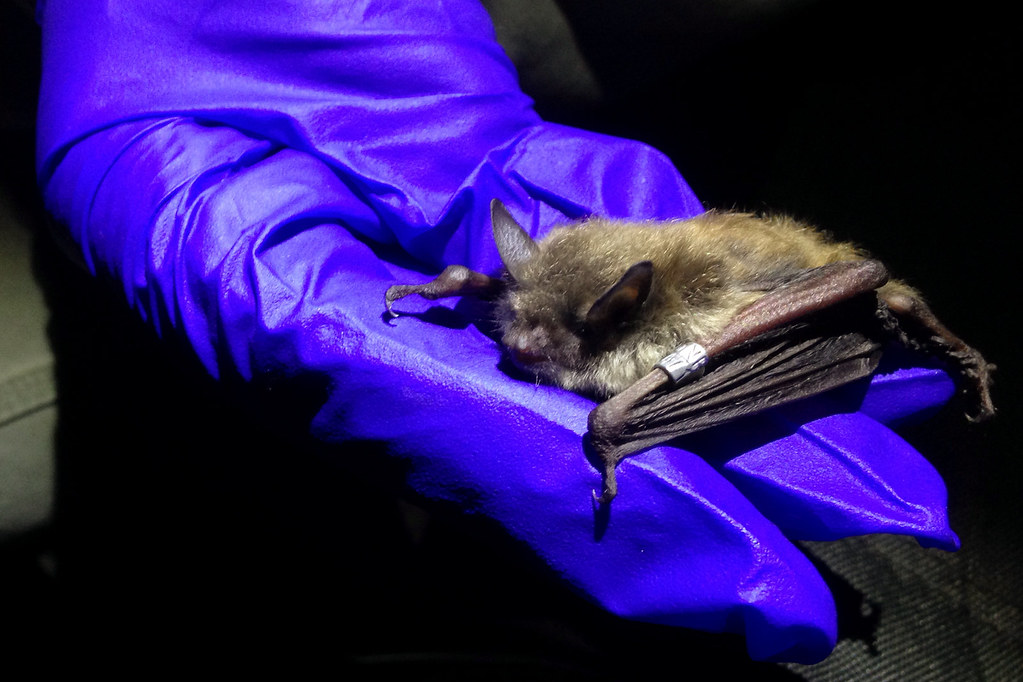Little Brown Bat
Myotis lucifugus
The little brown bat is a small, mostly nocturnal flying mammal with long, brownish fur. It lives in buildings, trees, caves and similar areas throughout the Chesapeake Bay watershed.
This section shows one large critter image at a time. Use the thumbnails that follow to select a specific image to display here.

This gallery contains a grid of small thumbnails. Selecting a thumbnail will change the main image in the preceding section.
Appearance
The little brown bat has long, glossy fur that can be golden, reddish, olive or dark brown. It has a dark brown or black face, ears and wing membranes. Its small ears usually do not extend past its nose when laid forward. It has large hind feet with long hairs that extend past the tips of the claws. Little brown bats usually grow to about 3.5 inches with a wingspan of 9 to 11 inches and usually weigh less than half an ounce. Females are slightly larger than males.
Feeding
The little brown bat mainly eats aquatic insects such as midges, mayflies and caddisflies. It also eat gnats, beetles, wasps, moths and crane flies. It feeds in fields, wooded areas, and near or over water while flying and will also eat insects while they are on the water’s surface. Most feeding takes place about two hours after dark.
The bat typically consumes half its body weight in insects every night; nursing females may consume up to 110 percent of their body weight. Bats use echolocation—short, ultrasonic calls that humans cannot hear—to detect prey.
Predators
Domestic cats are a major predator. Other predators include small carnivores such as mice, owls, hawks, snakes, weasels, martens, fishers and raccoons.
Flight
Little brown bats usually fly about 12 miles per hour, but can fly as fast as 21 to 22 miles per hour.
Voice
Vocalizations are few but include "honking" which in one context may aid in preventing mid-air collisions among foraging adults. Echolocation calls may allow individuals to locate active roosts and hibernation sites. The young produce isolation calls which aid in mother-young recognition.
Reproduction and Life Cycle
Mating occurs between random adult bats during late summer and early autumn in two phases: active and passive. During the active mating phase, both partners are awake and alert. Females in this phase usually mate with more than one male. During the passive mating phase, active males mate with torpid bats of both sexes.
Females delay ovulation, storing sperm for seven months between insemination in autumn and fertilization in spring. Gestation lasts 50 to 60 days, with pups born between June and July. During this time, females roost in nursery areas that are typically only occupied by females and their young. Males play no role in parental care.
Females give birth to just one pup per year. Young spend their first few weeks clinging to their mother’s nipple using their teeth and claws. Young are able to hear by day 2 and develop adult-like sensitive hearing by day 13. After three weeks, young are able to fly, and within four weeks of birth young are independent from their mothers. Little brown bats usually live 6 to 7 years, but can live for 10 or more years.
Did You Know?
- Little brown bats are also known as the little brown myotis.
- These bats occupy different “roosts” depending on temperature and time of year. Day roosts have little to no light and usually have a southwestern exposure to provide heat. Night roosts are typically confined spaces where many bats can cluster together to increase the temperature. In winter, the bats hibernate in caves and abandoned mines with high humidity and above-freezing temperatures. They usually live close to water and are nocturnal, like all other bats.
- They spend a large amount of time every day grooming their fur and wing membranes.
- During the day and throughout the winter hibernation, little brown bats enter torpor: a state of reduced body activity in which temperature, breathing, heart rates and other bodily functions are lowered to conserve energy.
Sources and Additional Information
- Field Guide to Maryland Bats – Maryland Department of Natural Resources
- Animal Diversity Web: Little Brown Bat – University of Michigan Museum of Zoology
- North American Mammals: Myotis lucifugus – Smithsonian National Museum of Natural History
